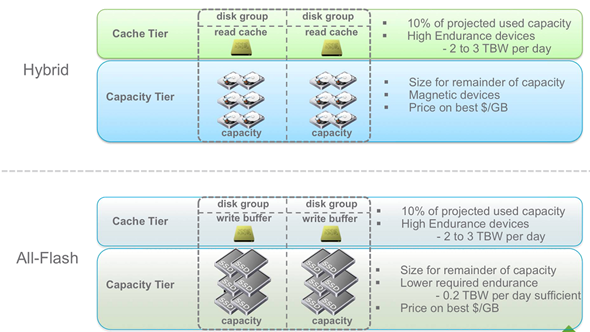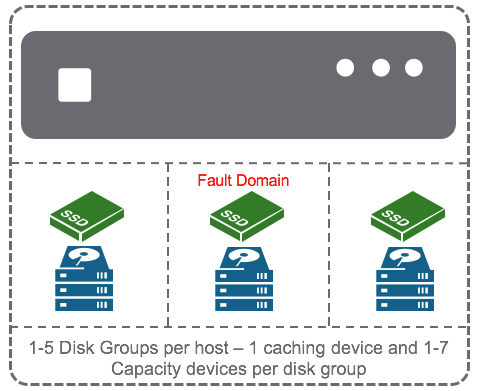May I know what is the compatible Enterprise NVME and SSD disks for this R630 servers. Disk Groups Design Background.

One Versus Multiple Vsan Disk Groups Per Host Yellow Bricks
Disk groups compose the distributed flash tier and storage capacity of the Virtual SAN datastore.
. I would assume identical behavior as case above except writes are distributed over disk or disk groups. Each disk group must have one flash cache device and one or multiple capacity devices. I have gone through the vSAN 62 Design and Sizing Guide the vSAN 62 Network Design Guide and the vSAN 62 Stretched Cluster 2 Node Guide 230 pages and aggregated all of the design decisions design considerations and best practices into one page of bullet points that is easy to consume.
Typically a higher SSD to HDD ratio both in size and quantity improves performance. 5 2 TB SSD disks for capacity. A cache tier for the purpose of read caching and write buffering and a capacity tier for persistent storage.
Disk group sizing is an important factor during the volume design. As you can see from the above image that there is some limitations on vSAN Disk Groups. A host can have up to five disk groups.
Each disk group contains one cache drive which must be a flash-based storage device. While one disk group per host is supported two or more disk groups per host is recommended. It ensures that data in the cluster remains available in the event of a single host or a group of hosts such as a rack or a data closet are.
Capacity can be scaled up by adding devices to a host or scaled out by adding more hosts. All data on a disk group must be evacuated to other disk groups in the cluster before the reformat process can proceed. If more ESXi hosts are available in a cluster more failures are tolerated in the cluster.
The optimal number of disk groups is a balance between hardware and space requirements for the vSAN datastore. VSAN cluster devices are organized into disk groups. The creation of a disk group requires the assignment of a single flash-based deviceSAS SATA or PCIe SSDand one or more magnetic disksSAS or SATA HDD.
More disk groups increase space and provide higher availability. 1 800 GB NVME for the cache with PCIE 30. More available disk groups can increase the recoverability of vSAN during a failure.
Disk group 2. VSan does not take differences in hardware performance into consideration FTT1Stripes2 Q. Type a name for the cluster in the Name box.
In hybrid clusters flash devices are used for the. Design and Operation Considerations When Using vSAN Fault Domains. VSAN Disk Group Test vSAN architecture consists of two tiers.
VMware vSAN uses an aggregation of disk groups to create a single datastore when you enable vSAN. I presented a number of VSAN sessions including a design and sizing session. This is an event for our field folks in EMEA.
VSAN is a hyper-converged storage software that is fully integrated with the hypervisor. In the past weve only ever really talked about the host memory requirements for disk group configuration as highlighted in this post here. The devices used for caching cannot be shared across disk groups and cannot be used for other purposes.
The number of disk groups can affect availability and performance. VSAN Disk group is an logical container of storage where multiple disks are present. Configure VMware Distributed Resource Scheduler DRS vSphere High Availability HA and.
VSAN Disk Group View. VSAN cluster devices are organized into disk groups. Where all Disk Groups contributes storage and all are aggregated into one datastore.
All of the cache devices across the disk groups in every host is referred to as the cache tier. VSAN Design Considerations Using Large Capacity Storage Devices Pete Koehler June 9 2020 vSAN and VMware Cloud Foundation environments powered by vSAN offer extraordinary flexibility in scaling. Vmware vsan is a hypervisor-converged software-defined storage platform that is fully integrated with vmware vsphere.
By using vSAN you have a high level of control over the storage subsystem. Right-click a data center and select New Cluster. VSAN uses disk groups instead of single disks to form a datastore.
The first step of creating a vSAN cluster is creating a vSphere cluster. The devices used for caching cannot be shared across disk groups and cannot be used for other purposes. The fault domains feature in vSAN is an optional configuration option to improve the resilience of a cluster based on your topology.
In hybrid clusters flash devices are used for the. Multiple disk groups mean multiple cache devices. 2 rows Disk group sizing is an important factor during volume design.
This capability adds cost because additional hardware is required for the disk groups. This two tier design offers supreme performance to VMs while ensuring that devices can have data written to them in the most efficient way possible. By default vSAN will ensure data is compliant with storage policies during the operation.
If more ESXi hosts are. Each disk group must have one flash cache device and one or multiple capacity devices. A single caching device must be dedicated to a single disk group.
A single caching device must be dedicated to a single disk group. As part of that session the topic of VSAN memory consumption was raised. This design approach has the following benefits.
I hopethe above VSAN disk group design will work out. If you read any other articles on my blog you will realise that I. A vSAN host with one disk group is supported but a common design recommendation calls for at least two disk groups.
When deduplication and compression or encryption are enabled or disabled vSAN performs a rolling reformat of each disk group. Vsan enables the rapid provisioning of storage within vmware vcenter as part of virtual. A vSAN disk group consists of one device for the cache tier and one to seven devices for the capacity tier.
3 rows A converstation occured around the design and layout of the Disk Groups construct that. Are stripes per disk or per disk group ie striping possible on 2 disks in the same disk group. Vsan aggregates locally attached disks of hosts that are members of a vsphere cluster to create a distributed shared storage solution.
However adding disk groups can be cost-prohibitive. This can be scaled up to five disk groups. In the disk group the SSD primarily serves as a read cache write buffer while the HDDs are used for permanent storage.
This design uses VMware vSAN to implement software-defined storage as the principal storage type for the management cluster.
Virtual Blocks Understanding Vsan Architecture Disk Groups

Vsan Disk Groups Mastering Vmware

Vmware Vsan Design Guide Vmware

What Is Vmware Vsan Disk Group Esx Virtualization
Virtual Blocks Understanding Vsan Architecture Disk Groups
Virtual Blocks Understanding Vsan Architecture Disk Groups

.png)
0 comments
Post a Comment